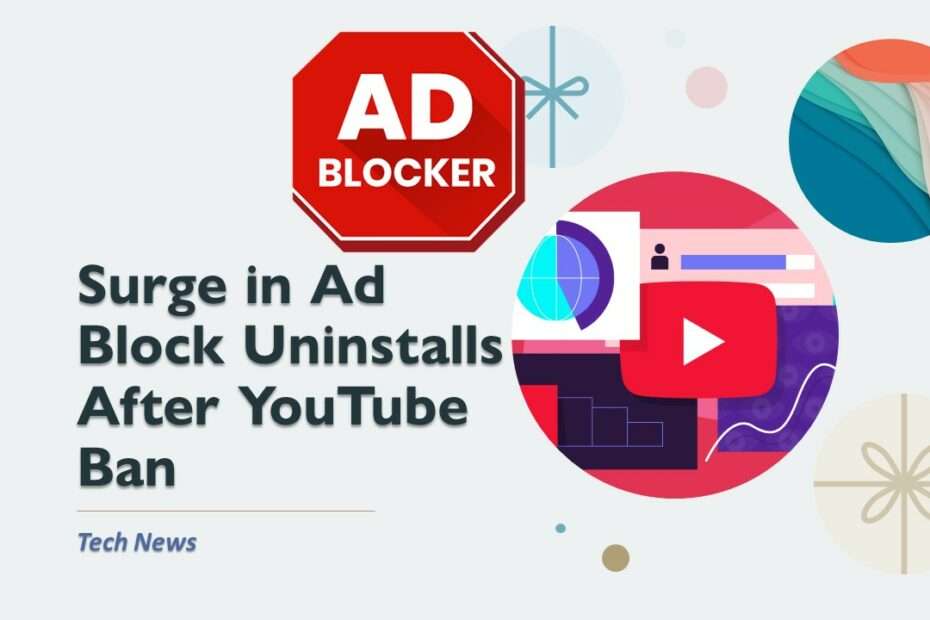YouTube has taken a decisive step in its ongoing battle against ad blockers by initiating a global campaign to prevent users from bypassing ads on its platform. Although early reports suggest that this campaign is beginning to make an impact, its overall effectiveness remains relatively minimal in its current stage.
In an effort to combat the increasing use of ad blockers, YouTube’s global campaign is a significant development. However, it’s important to note that the campaign is still in its early stages and may require further refinement to achieve more substantial results in the future.
AdGuard, a prominent ad-blocking provider with approximately 75 million users, shared data with Wired indicating a significant surge in uninstalls of its Chrome extension. Between October 9 and the end of the month, daily uninstalls increased to approximately 11.000, with a notable peak of about 52.000 uninstalls occurring on October 18. This marked a substantial deviation from the usual rate of around 6.000 daily uninstalls experienced by the company.
The sudden and sharp increase in uninstalls of AdGuard’s Chrome extension during this period suggests that there was a strong reaction from users in response to the ongoing efforts by YouTube to combat ad blockers. The data highlights the impact that YouTube’s global campaign against ad blockers had on users’ behavior, leading to a significant rise in users removing ad-blocking extensions from their browsers.
Throughout October, Ghostery, an ad block developer, saw a noteworthy fluctuation in user activity related to ad-block extensions. According to Modras, the company’s director of product and engineering, they observed a surge in both uninstalls and installs, with the daily figures being three to five times higher than their usual numbers. Despite these significant changes, the overall usage of Ghostery’s ad-blocking extension remained relatively stable during this period.
Modras noted a significant trend in user behavior during October. He reported that a vast majority of users who uninstalled Ghostery and participated in a survey cited the tool’s inability to block ads on YouTube as the primary reason for removing it. This finding underscores the impact of YouTube’s actions against ad blockers on users’ choices regarding their ad-blocking extensions. Interestingly, Ghostery also observed a 30 percent increase in installations of its extension on the Microsoft Edge browser in October compared to the previous month, indicating that users are actively seeking alternative solutions to bypass YouTube’s ad-blocker ban.
The data from Ghostery highlights the determination of users to continue enjoying ad-free content on YouTube, even in the face of measures to restrict ad-blocker usage. The increase in Edge installations suggests that users are actively searching for workarounds to counter YouTube’s efforts, emphasizing the importance of ad-blocking technology to users and their willingness to adapt in response to restrictions.
AdLock, yet another ad-blocking provider, experienced a notable increase in daily installations and uninstalls during the month of October. Their figures reflected a surge of approximately 30 percent above their typical rates, indicating a heightened level of activity and user engagement with ad-blocking solutions during this period.
The escalating conflict between YouTube and ad-blocking providers is far from over. As YouTube continues to enhance its ad-blocker blocking technology, engineers from these providers will be tirelessly working to find innovative ways to circumvent these measures. This situation mirrors the ongoing battle between malware creators and the cybersecurity companies dedicated to safeguarding web users, where each side constantly strives to gain an upper hand. The evolving nature of this struggle underscores the dynamic landscape of online content and user preferences.
YouTube currently holds the upper hand in the ongoing conflict, primarily due to the limited rollout of its ad-blocker-blocking measures. This limited deployment poses a challenge for those attempting to counteract the restrictions since not all users are affected by the blockade. Without experiencing the block on their end, it becomes challenging for users to even begin devising effective workarounds. This situation highlights the importance of understanding the scope and impact of YouTube’s actions in addressing ad-blockers.
The fact that YouTube’s ad-blocker blockade has not reached all users underscores the complexity of this battle and the need for users to adapt and strategize based on the evolving landscape of ad-blocking technology and content delivery. It remains to be seen how this dynamic will continue to shape the behavior of users and ad-blocking providers in their efforts to navigate these restrictions.
For users who want to enjoy an ad-free experience on YouTube, the platform offers a solution in the form of YouTube Premium. This premium service, priced at $13.99 per month, provides an ad-free browsing experience, along with other features such as offline downloads and access to YouTube Originals. By subscribing to YouTube Premium, users can effectively bypass the annoyance of ads and enjoy uninterrupted content consumption on the platform. This option caters to individuals who are willing to invest in an ad-free experience and the additional benefits that come with the premium subscription, ultimately providing an alternative to ad-blockers for those who value an uninterrupted viewing experience.
Maybe you liked other articles too?

